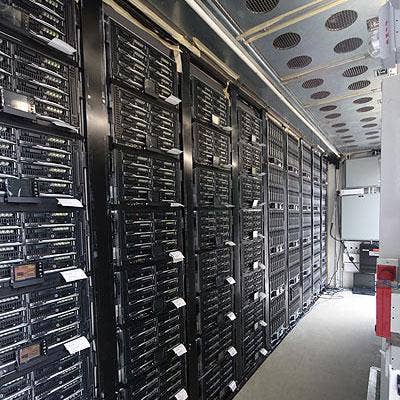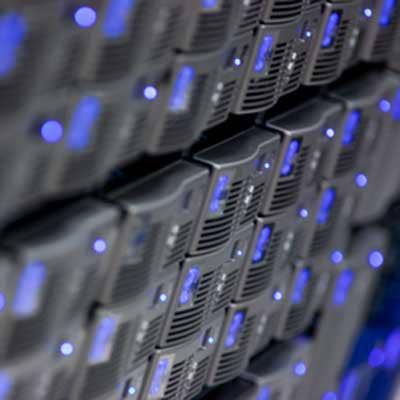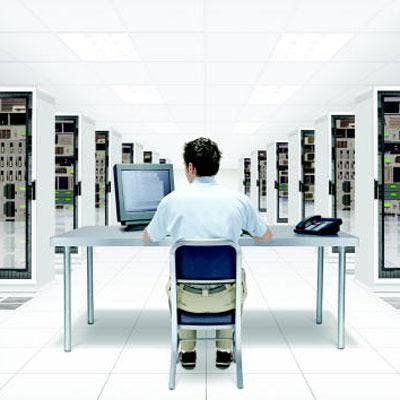11 Data Center Predictions For 2011

Data Centers 2011: Converged Virtual Green Clouds, For A Start
Think 2011 was a year of major changes in the data center? Just wait for 2011!
The adoption of new technologies will make data centers greener, more virtual, more able to connect to the cloud and more converged. While such changes offer data center customers such potential benefits as lower capital and operating costs, not to mention cutting back on space requirements, they will also force data center admins and their solution provider partners to invest in new skills to better run them even as businesses try to throttle back on spending.
Data centers are in for major change next year. Then again, one could have said that every year for the past 30 years.

The Growing Consumerization Of The Data Center
Shortly after Apple's iPad hit the market in 2010, an astounding number of business apps for the device appeared. IDC expects 25 billion mobile apps to be downloaded in 2011, up from 10 million in 2010.
2011 will see the release of the second generation of the iPad as well as a variety of iPad wannabees. Many of these will come from vendors with strong business credentials looking to differentiate themselves from the consumer-oriented iPad. The new crop of tablets, as well as new smart phones, may function as PC replacements, or as specialized data input and retrieval devices, or as ways to better remotely manage business operations, forcing data centers to start investing heavily in technology to provide the needed integration and, especially, security.

Greening Up The Data Center
Analyst firm Gartner estimates that energy accounts for 12 percent of data center expenses, making data center energy efficiency a major concern in 2011 as customers look for ways to not only control costs but also to promote themselves as "green."
While exotic forms of renewable energy such as cow pies may not work for every data center, customers will increasingly look for better ways to cut power consumption. These include the use of outside air to replace some of the mechanical air conditioning, increased use of water for cooling, and even raising the thermostat to up to 80.6 degrees Fahrenheit in line with new guidelines from the American Society of Heating, Refrigerating and Air-Conditioning Engineers.

Need New Hardware? Virtualize It Instead
If it can be virtualized, it will be.
The number of new virtual servers being deployed probably exceeded the number of new physical servers deployed starting last year, and the gap will only grow. Meanwhile, virtual versions of appliances ranging from storage arrays to WAN appliances to networking switches are increasingly available.
Why virtual appliances? Not only do they cost less than physical appliances, they are often the only way to get a server or WAN appliance or storage array into a public cloud, where the doors are locked to customers looking to add their own hardware.
However, virtual appliances may not always be the best solution, as performance suffers compared to that of physical appliances.

Public, Private, Or Hybrid -- Gotta Deal With The Cloud
Administrators and solution providers will need to adjust how they design, operate and manage data centers as customers increasingly look to cloud computing in 2011 and beyond.
If customers adopt private clouds, which seems to be the primary move to cloud computing for now, the adjustment may not be too traumatic, as it involves either bringing in new technology or repurposing existing technology in the data center, from where admins still maintain control.
But as customers push more of their data and applications to public clouds, admins could lose control of vital parts of the IT infrastructure and experience a loss of investment in their own data centers.
For hybrid clouds, which are private clouds connected to public clouds, the level of investment and control lies between the two.

Colos In An Age Of Clouds
As cloud computing becomes more commonplace, data centers looking for flexible expansion are more likely to turn to clouds than to colocation centers.
Cloud computing is good for several small workloads, or for peak workloads, or any workloads which do not require a specific set of resources. This is because the cost of maintaining a dedicated infrastructure, whether on-site or in a colo, is high in comparison to the utilization of that infrastructure.
For data center operations with less flexible workloads, or which are approaching 100 percent utilization of resources, colocation can be more attractive.

Converged Infrastructures Will Continue To Accelerate
Vendors who are working to converge server, storage and networking into a single managed resource (think HP, Cisco, and Dell), or who are converging software and hardware into a single appliance-like offering (think Oracle) will pump up the acquisition engine in 2011.
Why? Converged infrastructure is a way to lock customers in and competitors out, especially as data centers increasingly get connected to the cloud, which will eventually be provided by the very same vendors who build the infrastructure in the first place.
Watch for these potential acquisitions:
- Storage vendors like NetApp, CommVault or Xiotech.
- Networking vendors like Brocade or Juniper.
- Software vendors like SAP.

Hot Dang! There's A Data Center A'Movin' Thisaway
For new data centers, building in rural areas instead of in larger cities is becoming more common as businesses look for lower land, power and personnel costs. Such businesses can follow the example of large data center operators including Google, Amazon, Apple and Microsoft, all of which are eying rural locations for expansion.
But building data centers in rural America does not come without a price. According to the Data Center Journal, data centers in rural areas can increase property taxes without increasing the incomes of local residents. They also bring other issues such as adverse environmental impacts and the impacts of tax breaks for local governments.

Recruiting Troubles
Data centers require a wide range of skills with such technologies as storage, networking and applications. Unfortunately, even as such skills are evolving quickly due to evolutions in technology such as cloud computing and converged infrastructures, businesses are taking a short-term look at the slow-growth economy and are cutting back on skilled personnel.
That could mean good news for solution providers who are more likely to be called in to support data center customers who are either having trouble finding employees with the right skills or are in a budget cutting mode. But that just brings up a follow-up problem: where will those solution providers find enough skilled people?

Keep That Data Moving
Data centers will have new choices for their networking requirements, including the gradual appearance of such technologies as 40-Gbps and 100-Gbps Ethernet and 16-Gbps Fibre Channel. They won't be particularly widespread in 2011, but will be available for trials and initial implementations.
In addition to meeting the needs of ever-more bandwidth-hungry applications such as video streaming and mobile data, such technologies will also start pushing copper cabling, with its very limited range, aside in favor of fibre cabling, and should also start pushing down the cost of 10-Gbps Ethernet.

IT Spending Related to Data Centers Will Grow In 2011
IDC in December said it expects overall 2011 IT spending to grow 5.7 percent over 2010 to reach $1.6 trillion, with much of that growth coming in IT segments critical to the growth of data centers.
In that report, IDC said it estimates hardware spending to grow 7.8 percent, project-based services by 3.5 percent and outsourcing by 4.0 percent in 2011.
But the real growth will come from spending on public IT cloud services, which IDC expects to rise by 30 percent in 2011, and on social business software, which IDC said will grow by 38 percent annually through 2014.
Gartner in August estimated 2011 worldwide IT spending to rise by 3.5 percent over 2010 to reach about $2.5 billion, but warned IT suppliers to be prepared for the low but real possibility of no growth at all.